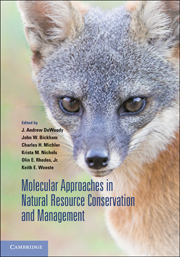Book contents
- Frontmatter
- Contents
- Contributors
- Preface
- 1 Biodiversity discovery and its importance to conservation
- 2 Gene flow, biodiversity, and genetically modified crops: Weedy rice in Thailand
- 3 A community and ecosystem genetics approach to conservation biology and management
- 4 Vertebrate sex-determining genes and their potential utility in conservation, with particular emphasis on fishes
- 5 Historical and contemporary dynamics of adaptive differentiation in European oaks
- 6 Association genetics, population genomics, and conservation: Revealing the genes underlying adaptation in natural populations of plants and animals
- 7 Hybridization in threatened and endangered animal taxa: Implications for conservation and management of biodiversity
- 8 Pollen and seed movement in disturbed tropical landscapes
- 9 Implications of landscape alteration for the conservation of genetic diversity of endangered species
- 10 Integrating evolutionary considerations into recovery planning for Pacific salmon
- 11 Using molecular methods to improve the genetic management of captive breeding programs for threatened species
- 12 Wildlife reintroductions: The conceptual development and application of theory
- 13 Evolutionary toxicology
- Index
- Plates
- References
1 - Biodiversity discovery and its importance to conservation
Published online by Cambridge University Press: 05 July 2014
- Frontmatter
- Contents
- Contributors
- Preface
- 1 Biodiversity discovery and its importance to conservation
- 2 Gene flow, biodiversity, and genetically modified crops: Weedy rice in Thailand
- 3 A community and ecosystem genetics approach to conservation biology and management
- 4 Vertebrate sex-determining genes and their potential utility in conservation, with particular emphasis on fishes
- 5 Historical and contemporary dynamics of adaptive differentiation in European oaks
- 6 Association genetics, population genomics, and conservation: Revealing the genes underlying adaptation in natural populations of plants and animals
- 7 Hybridization in threatened and endangered animal taxa: Implications for conservation and management of biodiversity
- 8 Pollen and seed movement in disturbed tropical landscapes
- 9 Implications of landscape alteration for the conservation of genetic diversity of endangered species
- 10 Integrating evolutionary considerations into recovery planning for Pacific salmon
- 11 Using molecular methods to improve the genetic management of captive breeding programs for threatened species
- 12 Wildlife reintroductions: The conceptual development and application of theory
- 13 Evolutionary toxicology
- Index
- Plates
- References
Summary
During the eighteenth, nineteenth, and early twentieth centuries, scientific inventories of biodiversity flourished as naturalists participated in expeditions throughout different geographic regions of the world (Köhler et al. 2005). These expeditions and the various journals produced by many prominent naturalists provided materials for extensive scientific collections as well as accounts of the habits and habitats of both plant and animal species. Charles Darwin and Alfred Russel Wallace were part of this tradition, and both were students of biodiversity. They chronicled their adventures in South America, the Malay Archipelago, the Galapagos Islands, New Zealand, and Australia as they discovered new species, described geology, and encountered various cultures (Darwin 1845; Wallace 1869). These adventures honed their observational skills, and their experiences culminated in their parallel proposals of the theory of biological evolution by means of natural selection. The biodiversity and natural environments encountered by Darwin and Wallace have been altered, and both habitats and species described in their journals have and are being impacted at a drastic rate. The yellow-bridled finch (Melanodera xanthogramma), noted by Darwin as “common” in the Falkland Islands, is now gone, and, as predicted by Darwin, the Falkland Islands fox or warrah (Dusicyon australis) went extinct in 1876 (Armstrong 1994). The Borneo forest harbors fewer Mias or orangutans, and it is unlikely that one would be allowed to collect specimens like Wallace describes (Wallace 1869). Even “pristine” regions, such as those seen by Darwin in Patagonia and the southwest Atlantic coast of Argentina, are still poorly understood, yet they are threatened by numerous human activities (Bortolus & Schwindt 2007).
- Type
- Chapter
- Information
- Publisher: Cambridge University PressPrint publication year: 2010
References
- 3
- Cited by

